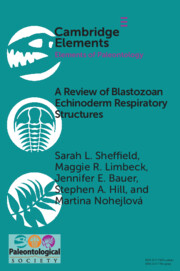Element contents
A Review of Blastozoan Echinoderm Respiratory Structures
Published online by Cambridge University Press: 16 December 2022
Summary
- Type
- Element
- Information
- Series: Elements of PaleontologyOnline ISBN: 9781108881821Publisher: Cambridge University PressPrint publication: 26 January 2023
References
- 2
- Cited by

